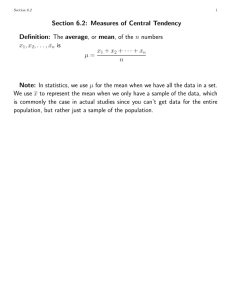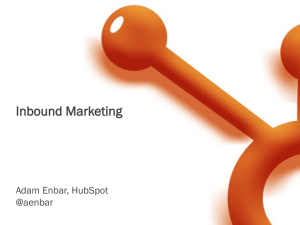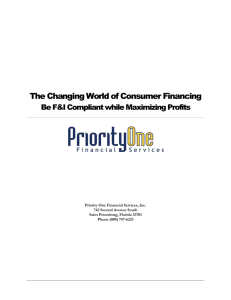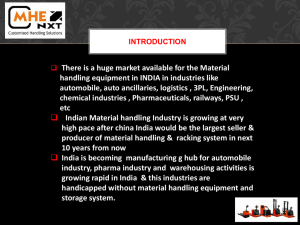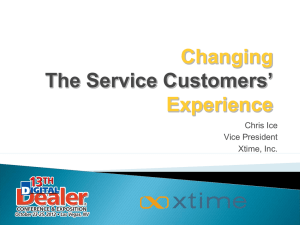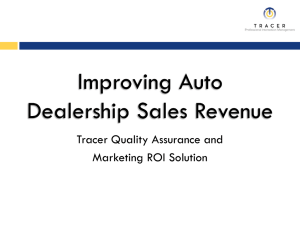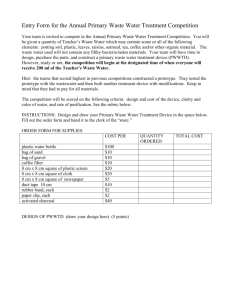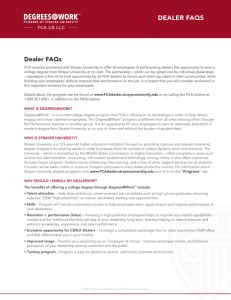What to Sell, What to Sell
advertisement
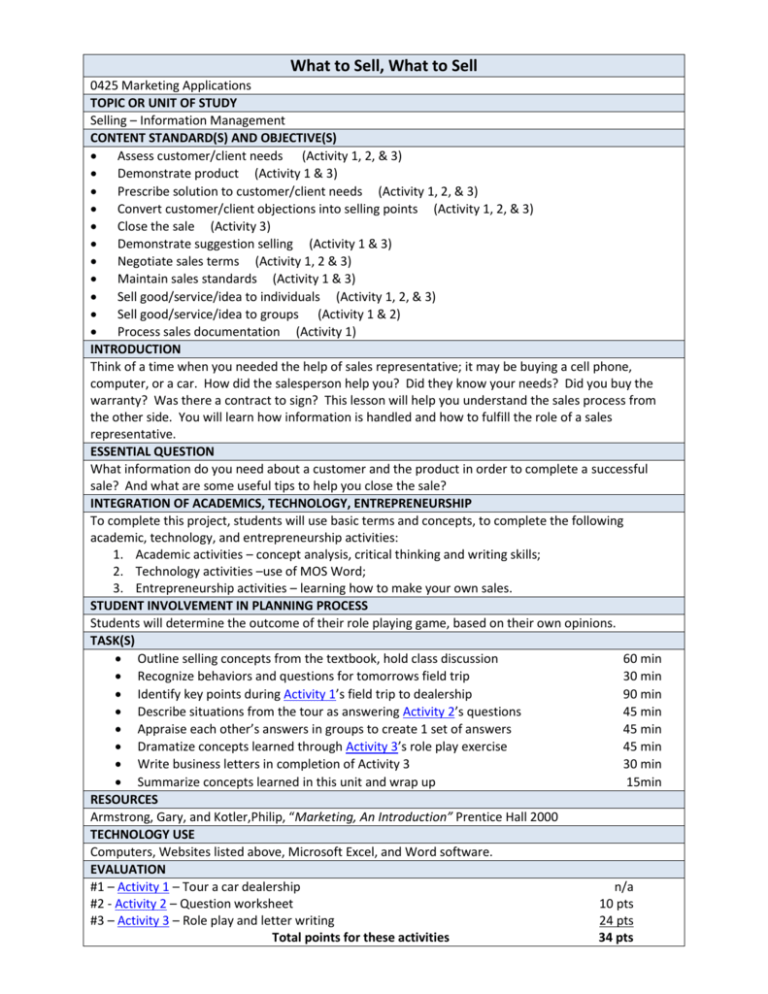
What to Sell, What to Sell 0425 Marketing Applications TOPIC OR UNIT OF STUDY Selling – Information Management CONTENT STANDARD(S) AND OBJECTIVE(S) Assess customer/client needs (Activity 1, 2, & 3) Demonstrate product (Activity 1 & 3) Prescribe solution to customer/client needs (Activity 1, 2, & 3) Convert customer/client objections into selling points (Activity 1, 2, & 3) Close the sale (Activity 3) Demonstrate suggestion selling (Activity 1 & 3) Negotiate sales terms (Activity 1, 2 & 3) Maintain sales standards (Activity 1 & 3) Sell good/service/idea to individuals (Activity 1, 2, & 3) Sell good/service/idea to groups (Activity 1 & 2) Process sales documentation (Activity 1) INTRODUCTION Think of a time when you needed the help of sales representative; it may be buying a cell phone, computer, or a car. How did the salesperson help you? Did they know your needs? Did you buy the warranty? Was there a contract to sign? This lesson will help you understand the sales process from the other side. You will learn how information is handled and how to fulfill the role of a sales representative. ESSENTIAL QUESTION What information do you need about a customer and the product in order to complete a successful sale? And what are some useful tips to help you close the sale? INTEGRATION OF ACADEMICS, TECHNOLOGY, ENTREPRENEURSHIP To complete this project, students will use basic terms and concepts, to complete the following academic, technology, and entrepreneurship activities: 1. Academic activities – concept analysis, critical thinking and writing skills; 2. Technology activities –use of MOS Word; 3. Entrepreneurship activities – learning how to make your own sales. STUDENT INVOLVEMENT IN PLANNING PROCESS Students will determine the outcome of their role playing game, based on their own opinions. TASK(S) Outline selling concepts from the textbook, hold class discussion 60 min Recognize behaviors and questions for tomorrows field trip 30 min Identify key points during Activity 1’s field trip to dealership 90 min Describe situations from the tour as answering Activity 2’s questions 45 min Appraise each other’s answers in groups to create 1 set of answers 45 min Dramatize concepts learned through Activity 3’s role play exercise 45 min Write business letters in completion of Activity 3 30 min Summarize concepts learned in this unit and wrap up 15min RESOURCES Armstrong, Gary, and Kotler,Philip, “Marketing, An Introduction” Prentice Hall 2000 TECHNOLOGY USE Computers, Websites listed above, Microsoft Excel, and Word software. EVALUATION #1 – Activity 1 – Tour a car dealership n/a #2 - Activity 2 – Question worksheet 10 pts #3 – Activity 3 – Role play and letter writing 24 pts Total points for these activities 34 pts Authentic assessments will be evaluated with the rubrics that are located on each activity TIMELINE Block scheduling-4 days, periods-8 days. This includes time for lecture, textbook readings, and discussions. Depending on student’s ability, extended time may be needed on some projects. Day 1 Outline selling concepts from the textbook, hold class discussion 60 min Recognize behaviors and questions for tomorrows field trip 30 min Day 2 Identify key points during Activity 1’s field trip to dealership 90 min Day 3 Describe situations from the tour as answering Activity 2’s questions 45 min Appraise each other’s answers in groups to create 1 set of answers 45 min Day 4 Dramatize concepts learned through Activity 3’s role play exercise 45 min Write business letters in completion of Activity 3 30 min Summarize concepts learned in this unit and wrap up 15min CONCLUSION At the conclusion of this unit students will understand how the selling function works with information management: how to learn the information about the product and the customer that helps to close the deal. Students will also learn negation tips and practice closing the deal with customers. Car Dealership Tour and Speaker To set the stage for this unit, class will visit a car dealership and a salesman will walk us through the process of selling a car. Pre-visit (This list was sent ahead to the salesmen weeks ago so they would have an idea of what to address) When a customer first comes to you, do they normally know what they want, have an idea, or really do not know at all? What kind of questions do you ask them the figure out their wants and need? Do you encourage customers to take a test drive? Do you show them all the interesting accessories in a vehicle? Do you make suggestion for certain vehicle? Why do you make those suggestions? What do you do if a customer has some negative views of a particular product? How do you take a customer’s objections to something and still make a sale? How do you close a sale? How do you keep from losing a sale? How do you know it is the right time for the customer? How can you negotiate sales terms? What are some things that you cannot do? How does this dealership maintain sales standards, what are some company policies that keep the standard? Do you ever sell to groups/businesses? Do you cater to interest groups? How do you process the sales information? How long do you keep it? What do you use it for? How are you supposed to document it? Remember this list was provided to the guide. (The dealer has had plenty of time to view the questions, but it is just a guide.) If a salesperson simply walks you through a sale from beginning to end it should answer all these questions and more. Questions for the Dealership Tour. (Answer the following questions keeping the tour in mind) 1. How does the salesperson get to know the customer’s needs? 2. Why is it important for customers to see how the car works and test drive it? 3. How can a salesman help a customer choose from all the vehicles to make sure the customer is happy? 4. If a sale or customer seems to doubt or show some negative emotion, what can you do? 5. What does it mean to close a sale? How do you do it? 6. What can a salesperson do to negotiate price? 7. What can this dealership offer groups of people or business? 8. What is the importance of keeping sales documentation? Points per question 1 pt 2 pts 3 pts 24 pt Content Points Earned for a short answer Answer is in complete sentence and well thought out Answer is in completes sentences, well thought out, and refers to different tings mention on the tour Total _____ of 24 pt Role Play Materials: Dealer Cards (numbered) Career Cards (numbered) Matchbox Cars (bag for each pair, names labels on the bottom) 1. Prepare cards for students. Half are Dealer Cards, half are Career Cards. On the Career cards, include the students’ occupation, marital status, children, income, and additional debt (other than the price of the car). 2. Students will draw from a hat. They will pair up or you could pair them up by writing a corresponding number on the career and dealership cards. 3. Students with a dealer card will try to sell the life-size model of a matchbox car to the student with a career card. 4. Dealers will reenact the sales tips they learned from the car salesperson at the dealership. 5. Both the dealer and the customer will have to come to an agreement on a car. 6. Both students will write a letter: o Customer must write a letter to the dealership sharing how their experience was at that dealership. o Dealer must write an inquiry letter about how the customer liked their car, or any added features. o Remember how to write the letters. Letter writing grades grade rubric 9-10 This document represents a polished, appropriately-designed effort that would be completely acceptable in a pts professional situation. It is totally error-free; moreover, it is executed with creativity and sensitivity to the nature and 7-8 pts 5-6 pts 3-4 pts 1-2 pts needs of the audience and make the best use of available communications presentation technology. The prose style is mature and tight, well-organized, and free of lard. Every part plays an important role in the document's effect and is connected by appropriate transitions. Any graphics are smoothly integrated and effectively placed for communicative success. The content shows that the writer knows how to find, select, and present information in the manner best suited to this audience. This document is less polished and appropriate than A documents, but again would be acceptable (if not notable) in a professional situation. They are also totally error-free, but are weaker than A papers in one or more of the following ways: The style is less tight or more lardy; transitions may be weaker; the appeal to the audience is less certain; the presentation is less polished; graphics may be less appropriate or less smoothly integrated; the content may be less complete or less sophisticated; the use of technology may be less fluent; or the writer may not demonstrate the ability to find, select, and present the right information in a totally appropriate manner. This document is virtually error-free, but is not yet appropriate for a professional situation for one or more of the following reasons: the style is immature, wordy, stilted, or inappropriate for the audience; the topic is mundane; the content is insufficiently developed or presented in a less-than-effective organization; the presentation is uncertain and shows amateurism; graphic information is ineffectively presented or interpreted or inappropriately placed; technology may not be used effectively; appropriate sources of information may not have been consulted; documentation of secondary information may be incomplete or inaccurate. With appropriate revisions these documents may be acceptable in a professional situation. This document contains errors in any or all of the following areas: spelling, grammar, mechanics, punctuation, or format. It may also suffer from one or more of the following weaknesses: inappropriate or casual style; insufficient audience analysis; poor organization or transitions; incomplete or inappropriate content; sloppy, hasty, or amateurish presentation; inaccuracies in data; poor choice of graphic contents, placement, or presentation; inappropriate, incomplete, or missing research; serious faults in documentation; or problems using available technology. This document requires substantial revision to be acceptable in a professional situation. This document does not meet basic standards for professional communication. It may exhibit one or more of the following weaknesses: inability to use standard grammar, spelling, punctuation, and mechanics; missing documentation; poor treatment of content; careless or inappropriate format and presentation; no control over technology; illogical organization; or an obviously inadequate amount of preparation. This document must be completely rewritten before they can be used in a professional situation.
